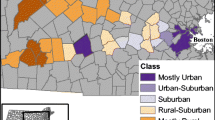Abstract
Land use decisions involve the allocation of space to competing demands. Space is perceived subjectively, particularly in respect to recreational use. Five groups involved in the decision-making process were asked to select from a list of acreages or percentages the closest approximation for each of five land use categories. The responses produced considerable variation from the correct answers. Designated park areas tended to be overestimated and designated forest lands underestimated. While some differences were associated with group affiliation; visibility of areas, political importance, experience of individual, mode of access, proximity, and role of group member may also have been important determinants. The importance of space perception is dependent on type of process in decision making; in particular whether the process is incremental or comprehensive.
Similar content being viewed by others
Literature cited
Beck, R. 1967. Spacial meaning, and the properties of the environment. Pages 18–41in D. Lowenthal, ed., Environmental perception and behavior, Dept. of Geography Research Paper No. 109. University of Chicago, Chicago, IL. 88 pp.
B.O.R.-U.S.D.I. 1977. Guidelines for understanding and determining optimum recreation carrying capacity. Washington, DC, USDI-R.O.R. 186 pp.
Cadwallander, M. 1979. Problems in cognitive distance: implication for cognitive mapping.Environment and Behavior 11:559.
Downs, R. and D. Strea. 1977. Maps in minds: Reflections on cognitive mapping. Harper and Row, New York, NY. 284 pp.
Gould, P. and R. White. 1974. Mental maps. Penguin Books. Baltimore, MD. 204 pp.
Hall, E. T. 1966. The hidden dimension. Doubleday and Co., Inc., Garden City, NY. 201 pp.
Knopp, T. B. and M. D. Bruder. 1981. Communicating quality in land use decision making. A paper prepared for the XVII International Union of Forestry Research Organizations World Congress, September 6–17, Kyoto, Japan. 7 pp.
Lucas, R. C. 1964. Wilderness perception and use: the example of the Boundary Waters Canoe Area.National Resources Journal 3:394–411.
Lucas, R. C. 1970. User concepts of wilderness and their implications for resource management. Pages 297–303in H. M. Proshansky, W. H. Ittelson, and L. G. Rivlin, eds., Environmental psychology: Man and his physical setting. Holt, Rinehart and Winston, Inc., New York, NY. 690 pp.
Merriam, L. C., Wald, K. D., and C. E. Ramsey. 1972. Public and professional definitions of the State Park: a Minnesota case.Journal of Leisure Research 4:259–274.
Moeller, G. H., R. Machachlan and D. A. Morrison. 1974. Measuring perception of elements in the outdoor environment. USDA Forest Service Research Paper NE 289. 9 pp.
Sadalla, E. K. 1980. An information storage model for distance cognition.Environment and Behavior 122: 183–193.
Sadalla, E. K. and S. G. Magel. 1980. The perception of traversed distance.Environment and Behavior 12:65–79.
Sommer, R. 1969. Personal space: The behavioral basis of design. Prentice-Hall, Inc., Englewood Cliffs, NJ. 177 pp.
Sonnenfeld, J. 1966. Variable values in space and landscape: an inquiry into the nature of environmental necessity.Journal of Social Issues 22:71–82.
Stankey, G. H. and D. W. Lime. 1973. Recreation Carrying Capacity: An Annotated Bibliography. USDA Forest Service, General Technical Report INT-3. Intermt. For. and Range Exp. Stn., Odgen, UT. 45 pp.
Thiel, P. 1970. Notes on the description, scaling, notation, and scoring of some perceptual and cognitive attributed of the physical environment. Pages 593–619in H. M. Proshansky,
W. H. Ittelson, and L. G. Rivlin, eds., Environmental psychology: Man and his physical setting. Holt, Rinehart and Winston, Inc., New York, NY. 690 pp.
Author information
Authors and Affiliations
Rights and permissions
About this article
Cite this article
Knopp, T.B., Bruder, M.D. Space perception as a factor in land use decision making. Environmental Management 6, 193–198 (1982). https://doi.org/10.1007/BF01866882
Issue Date:
DOI: https://doi.org/10.1007/BF01866882




